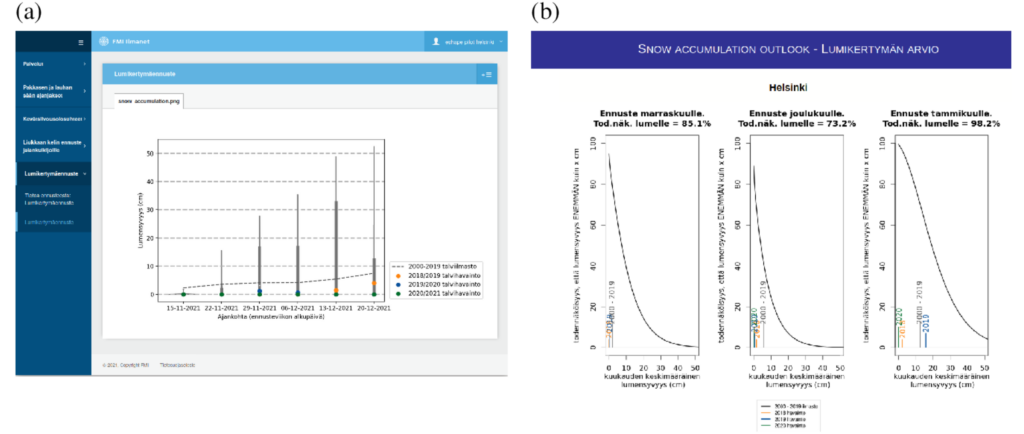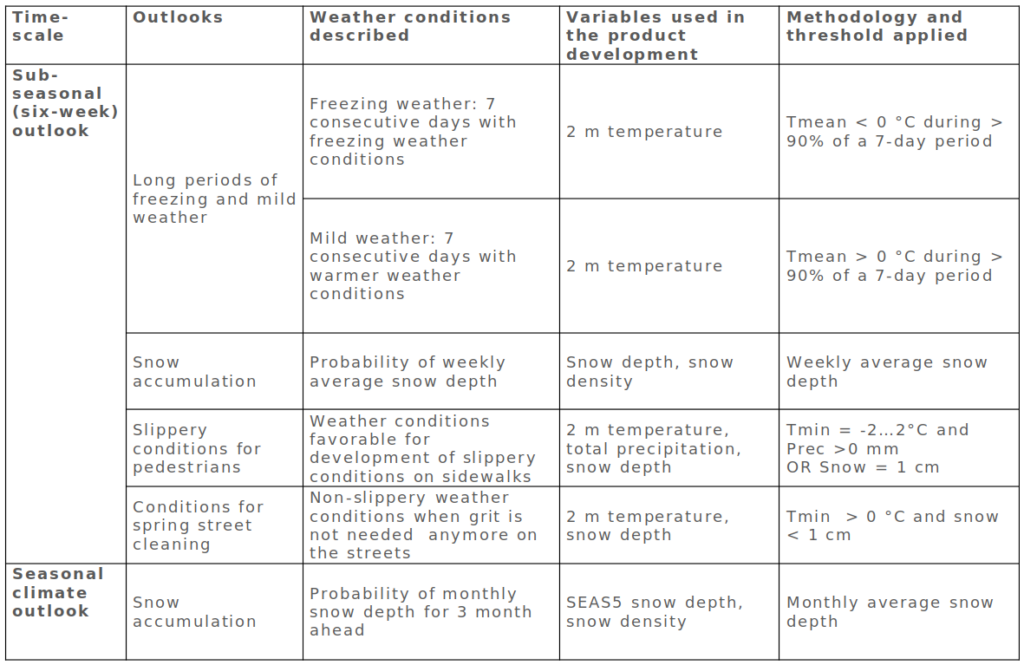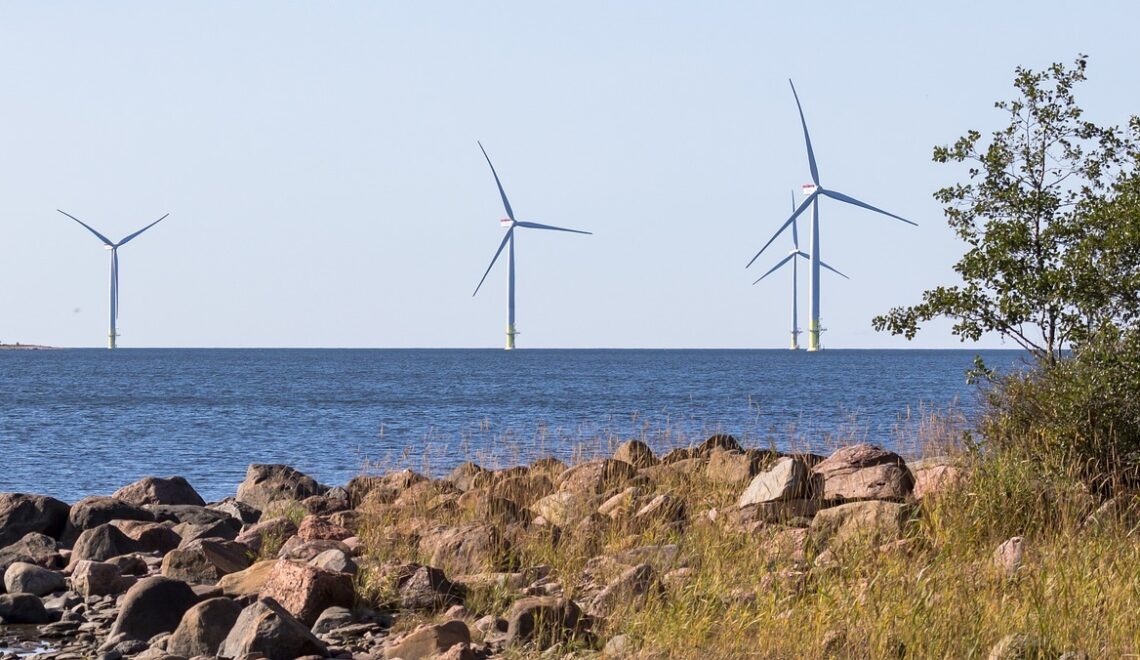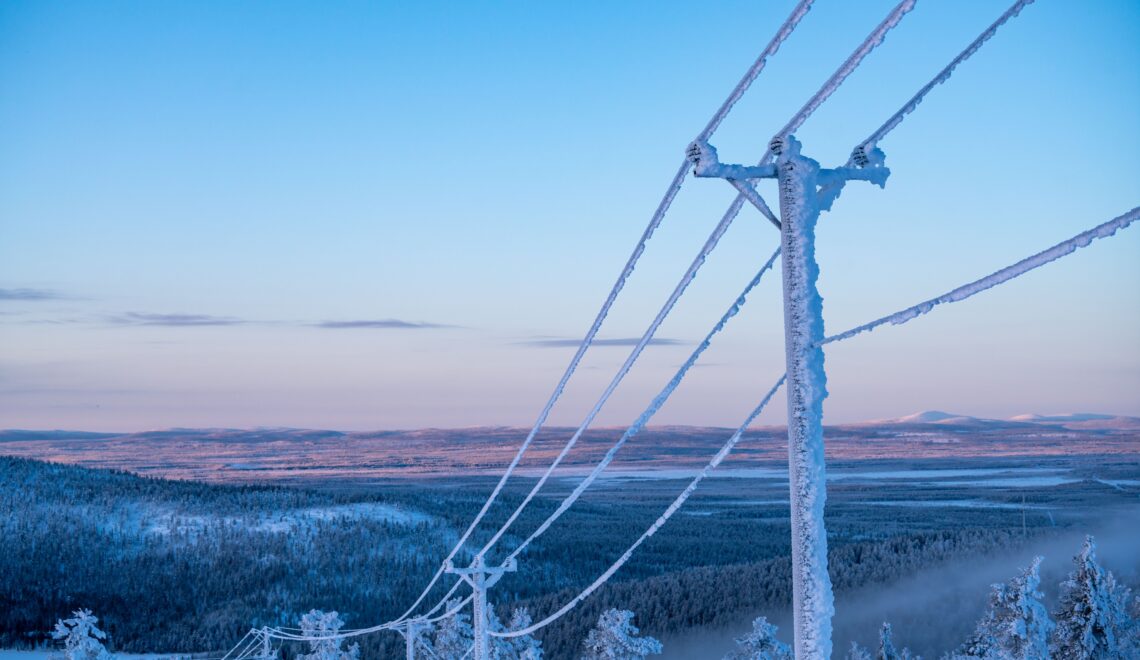Sub-seasonal and seasonal climate outlooks for winter street maintenance were developed and piloted by the Finnish Meteorological Institute in co-operation with the City of Helsinki.
OTTO HYVÄRINEN, ANDREA VAJDA, MIKA RANTANEN, ANDREAS TACK, MARKUS SILVENNOINEN
Finnish Meteorological Institute
In Helsinki, there are on average 95 days per year with snow cover (based on the observation period 2000–2019). However, winter conditions vary considerably from year to year. The City of Helsinki is responsible for the maintenance of streets in Helsinki. Winter street maintenance includes snow ploughing, the prevention of slipperiness by sanding, and street cleaning. Street cleaning includes sweeping up the sand and other grit accumulated over the winter months on the roadways, sidewalks and at public transportation stops, and is especially important in spring, after the snow season. Planning of these maintenance activities are currently done based on the short-term weather forecasts provided by the Finnish Meteorological Institute and from experience gained from the previous years. Within the H2020 e-shape project, under “S7-P2-Urban resilience to extreme weather”, a climate service providing sub-seasonal and seasonal climate outlooks tailored for winter street maintenance was developed in co-operation between the Finnish Meteorological Institute (FMI) and the City of Helsinki. Providing user-oriented sub-seasonal and seasonal forecast products tailored for winter maintenance activities serves city authorities in planning activities, improving winter safety, and optimizing maintenance costs.
The co-design and technical implementation. From the beginning, the City of Helsinki was engaged in the co-design and development process. Face-to-face and web-meetings were organized with the representatives of the Urban Environment Division of City of Helsinki. During the joint sessions, the potential offered by the sub-seasonal and seasonal forecasts for city management were discussed, forecast skill and uncertainties related to variables used in the development of outlooks were presented, and the most relevant sub-seasonal and seasonal forecast products were selected. Finally, the visualization and delivery modalities for the six-week and monthly outlooks was agreed.
Initially, the plan was to solely use seasonal-range forecasts. However, it became clear that the sub-seasonal forecast time scale is more relevant for maintenance work planning as most of the activities are scheduled on timescales of several weeks. Information on snow depth is needed also on the seasonal time scale for the preparation of snow dump sites and haulage. In the end, the following tailored sub-seasonal and seasonal forecast products were selected in the co-design development process for testing. These outlooks (see Table 1 for detailed definitions) were defined and designed in collaboration with the users, based on the current maintenance practices and additional information from literature:
- Snow accumulation (sub-seasonal and seasonal scale)
- Longer periods of freezing weather during winter (sub-seasonal scale)
- Longer periods of warm weather during winter (sub-seasonal scale)
- Slippery conditions for pedestrians (sub-seasonal scale)
- Conditions for spring street cleaning (sub-seasonal scale).
Some potential products were excluded due to the low skill of the variables, for example, forecasts of snow melt.
The forecast data used in the development of the sub-seasonal and seasonal climate outlooks are the extended-range forecast dataset provided by the ensemble prediction system of ECMWF (ECMWF 2016) and the SEAS5 long-range forecasting system of ECMWF (Johnson et al. 2019) available from Copernicus CDS. Sub-seasonal products are processed at FMI and disseminated through the Ilmatie/Ilmanet platform developed within FMI. The seasonal product, snow accumulation outlook, is processed in WEkEO, a Copernicus DIAS service and disseminated through the seasonal.fmi.fi web portal. Examples of weekly and monthly snow depth outlooks are presented in Fig. 1. The service was deployed, and the first weekly outlooks published in December 2020. The project timeline is divided into two Sprints, and Sprint 1 has been completed at the time of writing. During Sprint 1, sub-seasonal temperatures and seasonal snow accumulation have been bias-adjusted. The bias adjustment of sub-seasonal snow and precipitation will be explored in Sprint 2. Thus, the products are continuously improved in its usability.

The feedback on the outlooks. The feedback from the City of Helsinki was gathered after the first pilot season 2020–2021. Outlooks for snow accumulation, and for longer periods of freezing or mild weather during winter were found the most useful. The outlook of conditions for spring street cleaning was consulted, but often the sand was removed from the street before the product indicated suitable conditions. The forecast of periods of mild weather was more useful for this task. Moreover, the snow condition threshold in the spring street cleaning product (less than 1 cm of snow) proved to be too strict, as the sand can be removed even if some snow is present. For the user it is more important to know if new snow is expected in the near future.
The outlooks for slippery conditions were used as background information. However, as decisions to sand or not to sand are made on a daily basis, its benefit is still unclear. Moreover, it is also unclear if slippery conditions can be forecasted using the simple rule-based methodology used here or if more advanced methods should be explored in the future. The outlooks have been updated considering the feedback received from the user and will be tested during winter 2021–2022. The seasonal outlook of snow accumulation became available late in the season, so it will be tested during Sprint 2.
The City of Helsinki also expressed a wish for the quantitative validation of outlooks. This is planned for the near future. Some early results for sub-seasonal snow depth and 2 m temperature validation have been presented in Rantanen et al. (2021) and Vajda et al. (2021). A quantitative evaluation of the sub-seasonal forecast products will be performed following the second testing period, when a larger data pool will be available.
Acknowledgements: The study contributes to the H2020 e-shape project (grant 820852) funded by the European Commission.
References
ECMWF, 2016: IFS documentation CY43R2 – Part V: Ensemble Prediction System. 23 pp, https://www.ecmwf.int/node/17118.
Johnson, S. J., and Coauthors, 2019: SEAS5: The new ECMWF seasonal forecast system, Geosci. Model Dev., 12, 1087–1117, https://doi.org/10.5194/gmd-12-1087-2019.
Rantanen, M., M. Kämäräinen, O. Hyvärinen, and A. Vajda, 2021: Skill assessment of sub-seasonal 2-m temperature forecasts for Helsinki, Finland, EMS Annual Meeting 2021, online, 6–10 Sep 2021, EMS2021-138, https://doi.org/10.5194/ems2021-138.
Vajda, A., O. Hyvärinen, M. Rantanen, A. Tack, and M. Silvennoinen, 2022: Seasonal preparedness pilot – sub-seasonal and seasonal service for tyre companies, FMI’s Clim. Bull. Res. Lett., 4(1), 5–7, https://doi.org/10.35614/ISSN-2341-6408-IK-2022-02-RL.
HOW TO CITE THIS ARTICLE:
Hyvärinen O., A. Vajda, M. Rantanen, A. Tack, and M. Silvennoinen, 2022: Urban resilience to extreme weather – sub-seasonal and seasonal forecasts for winter maintenance activities in Helsinki, FMI’s Clim. Bull. Res. Lett., 4(1), 11–13, https://doi.org/10.35614/ISSN-2341-6408-IK-2022-04-RL.
CITATION INFORMATION:
Authors: Otto Hyvärinen, Andrea Vajda, Mika Rantanen, Andreas Tack, Markus Silvennoinen
Received: November 29, 2021
Accepted: March 23, 2022
First online: March 23, 2022
Published: September 2, 2022
Journal: FMI’s Climate Bulletin Research Letters
Volume: 4
Issue: 1
Pages: 11–13
DOI: https://doi.org/10.35614/ISSN-2341-6408-IK-2022-04-RL
This article is part of the e-shape Special Issue.
Header image: T. Pajukallio





